Abstract
The specificity of the unusual flavobacterial glycuronidases that act on disaccharides containing delta4,5-unsaturated uronic acids was reinvestigated. The results show that the enzyme that hydrolyses the uronidic bond in disaccharides from hyaluronic acid and the chondroitin sulphates appears to be mainly specific for beta-D-(1 leads to 3)-derived linkages. The enzyme that hydrolyses the uronidic bond in a variety of disaccharides obtained from heparan sulphate and heparin appears to be specific for beta-D-(1 leads to 4)- and alpha-L-(1 leads to 4)- derived linkages. Thus the glycuronidases seem to be specific for linkage position rather than anomeric configuration, as had been thought previously. In addition, the data confirm other evidence that the major glucuronidic linkages in heparan sulphate and heparin have the beta-D-configuration, and the iduronidic linkages the alpha-L-configuration.
Full text
PDF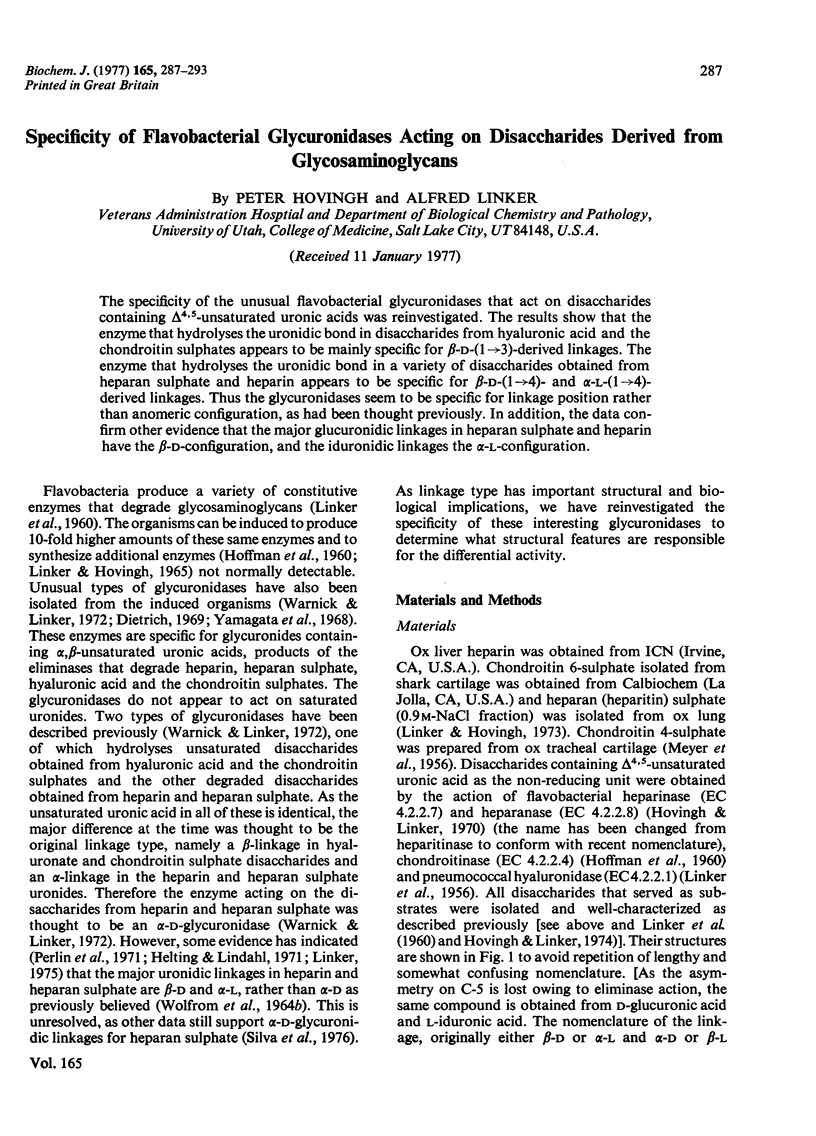
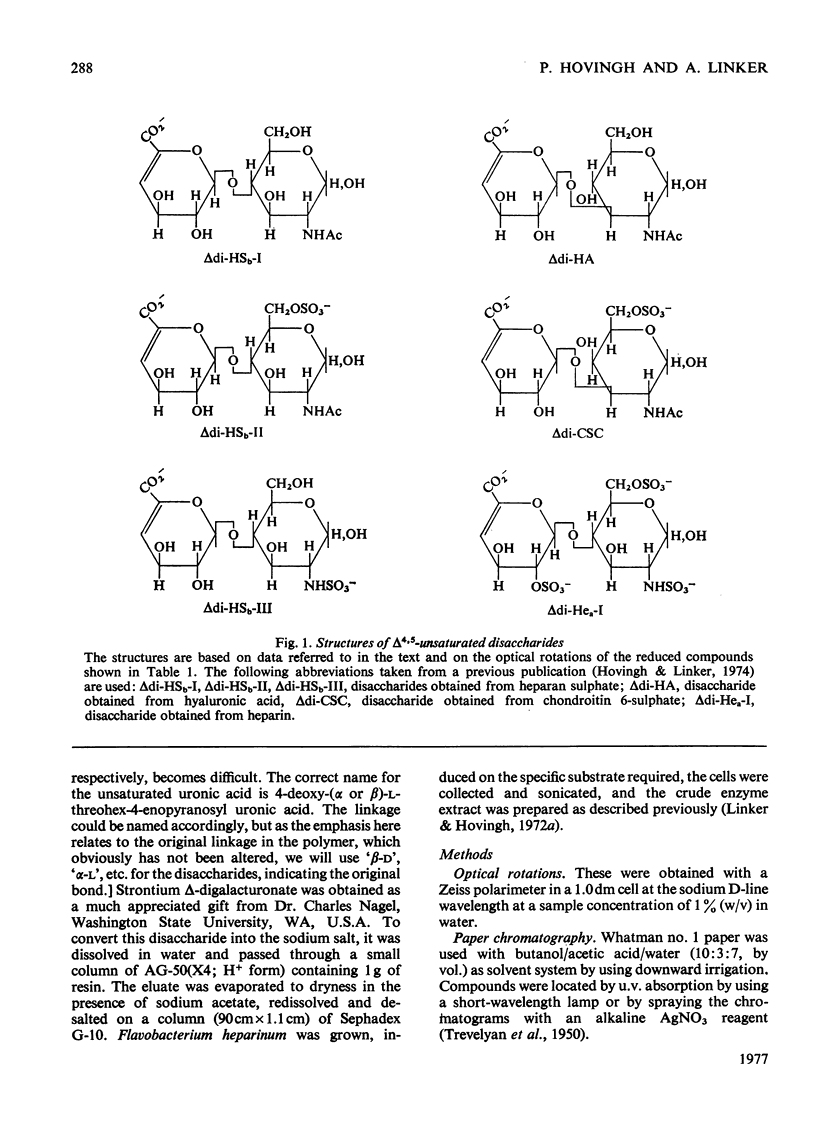
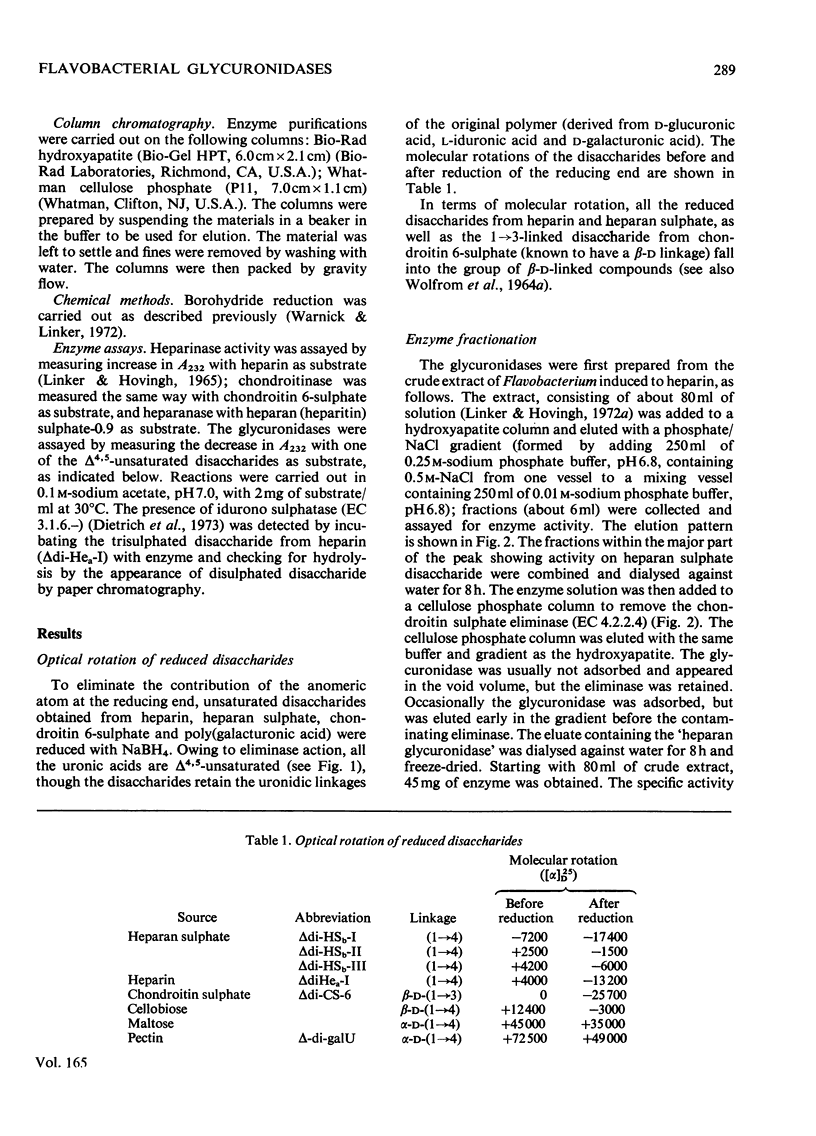
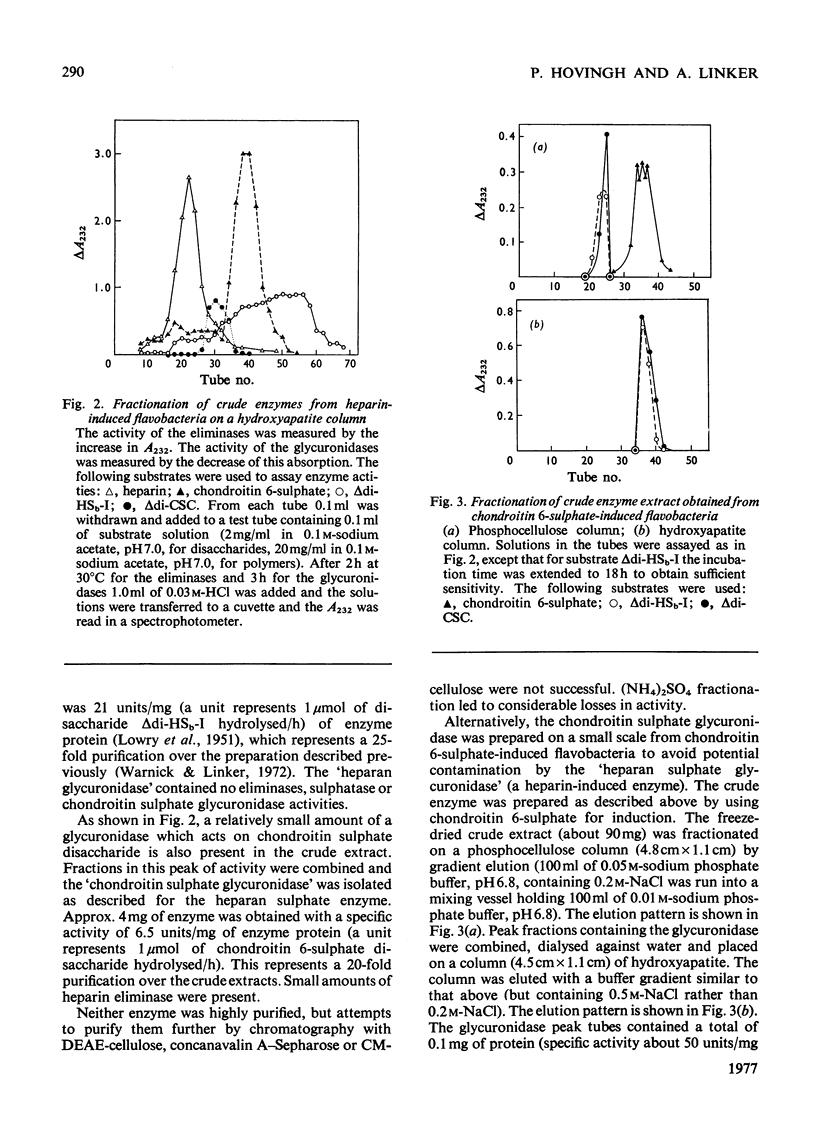
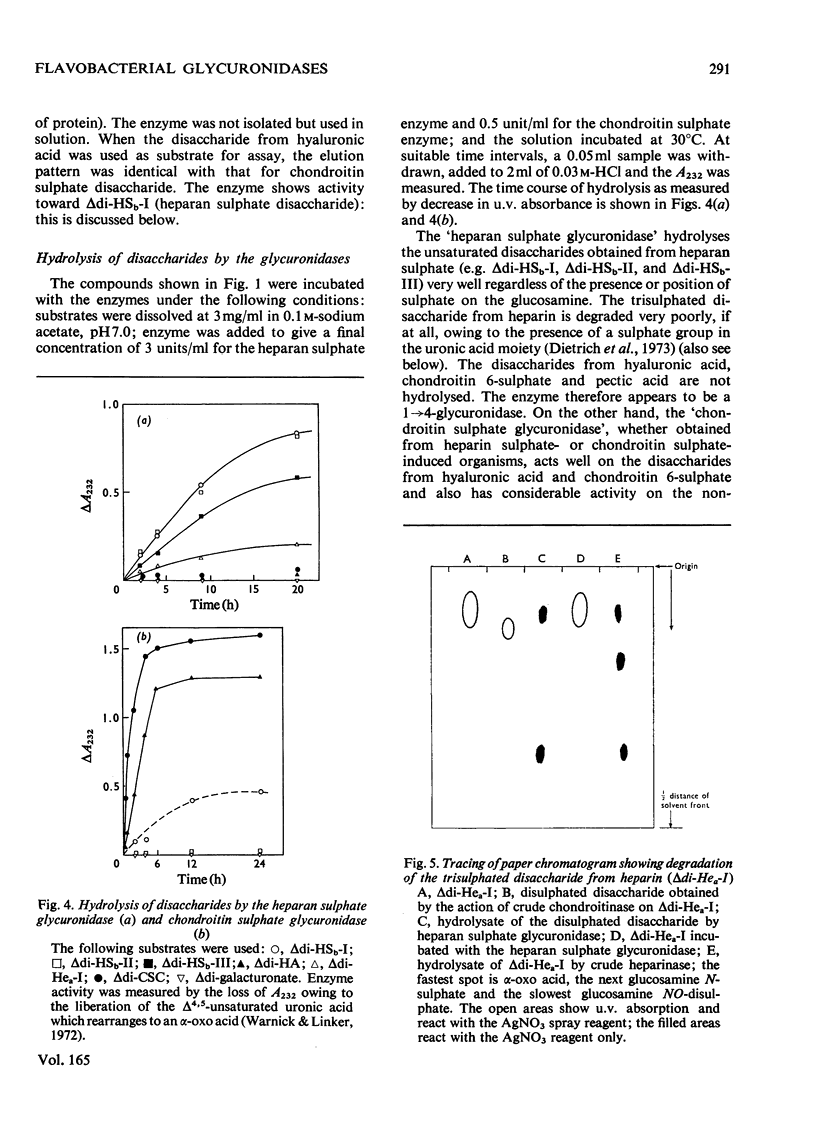
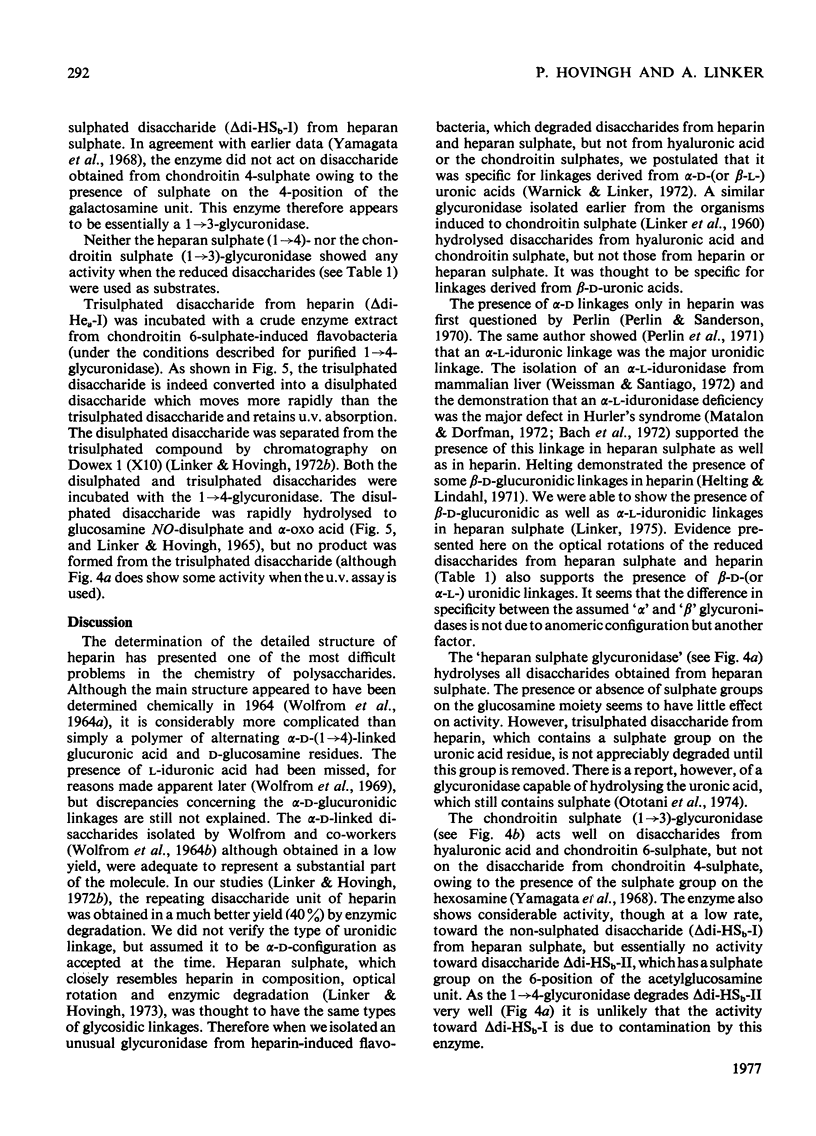
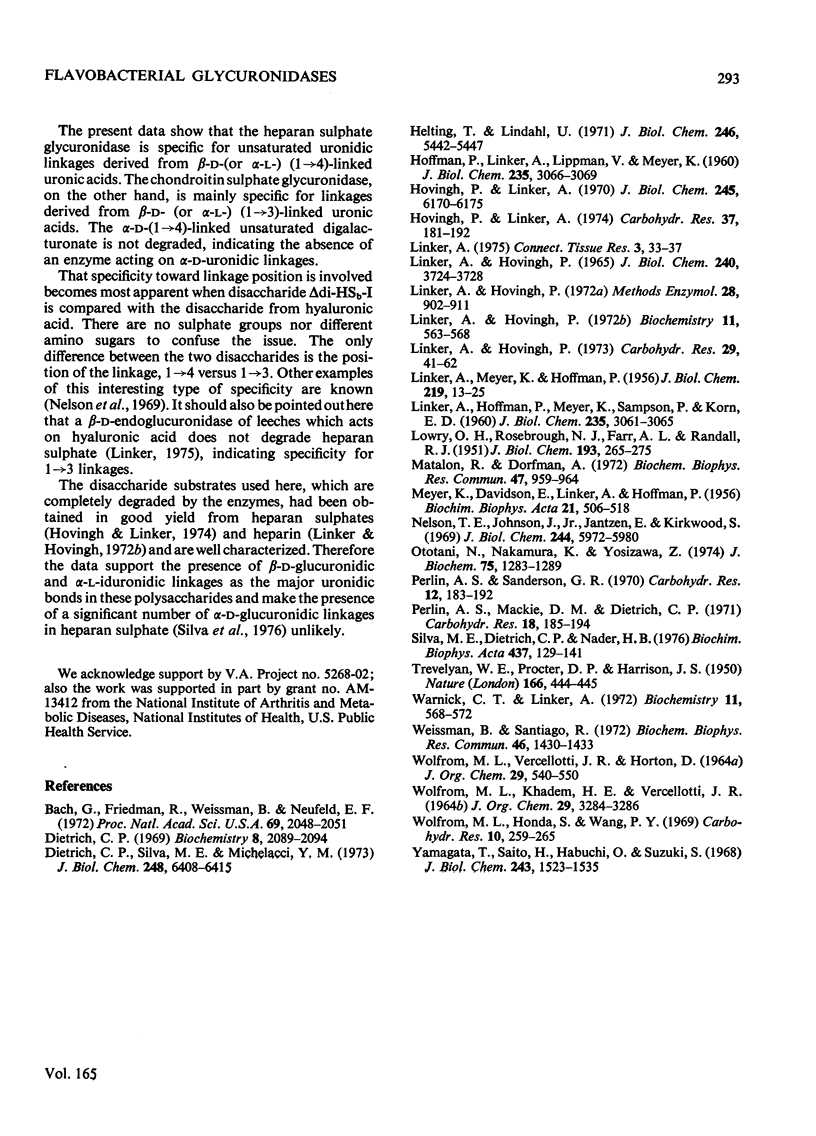
Selected References
These references are in PubMed. This may not be the complete list of references from this article.
- Bach G., Friedman R., Weissmann B., Neufeld E. F. The defect in the Hurler and Scheie syndromes: deficiency of -L-iduronidase. Proc Natl Acad Sci U S A. 1972 Aug;69(8):2048–2051. doi: 10.1073/pnas.69.8.2048. [DOI] [PMC free article] [PubMed] [Google Scholar]
- DAVIDSON E., HOFFMAN P., LINKER A., MEYER K. The acid mucopolysaccharides of connective tissue. Biochim Biophys Acta. 1956 Sep;21(3):506–518. doi: 10.1016/0006-3002(56)90188-3. [DOI] [PubMed] [Google Scholar]
- Dietrich C. P. Enzymic degradation of heparin. A glucosaminidase and a glycuronidase from Flavobacterium heparinum. Biochemistry. 1969 May;8(5):2089–2094. doi: 10.1021/bi00833a046. [DOI] [PubMed] [Google Scholar]
- Dietrich C. P., Silva M. E., Michelacci Y. M. Sequential degradation of heparin in Flavobacterium heparinum. Purification and properties of five enzymes involved in heparin degradation. J Biol Chem. 1973 Sep 25;248(18):6408–6415. [PubMed] [Google Scholar]
- HOFFMAN P., LINKER A., LIPPMAN V., MEYER K. The structure of chondroitin sulfate B from studies with Flavobacterium enzymes. J Biol Chem. 1960 Nov;235:3066–3069. [PubMed] [Google Scholar]
- Helting T., Lindahl U. Occurrence and biosynthesis of beta-glucuronidic linkages in heparin. J Biol Chem. 1971 Sep 10;246(17):5442–5447. [PubMed] [Google Scholar]
- Hovingh P., Linker A. The disaccharide repeating-units of heparan sulfate. Carbohydr Res. 1974 Oct;37(1):181–192. doi: 10.1016/s0008-6215(00)87073-1. [DOI] [PubMed] [Google Scholar]
- Hovingh P., Linker A. The enzymatic degradation of heparin and heparitin sulfate. 3. Purification of a heparitinase and a heparinase from flavobacteria. J Biol Chem. 1970 Nov 25;245(22):6170–6175. [PubMed] [Google Scholar]
- LINKER A., HOFFMAN P., MEYER K., SAMPSON P., KORN E. D. The formation of unsaturated disacharides from mucopoly-saccharides and their cleavage to alpha-keto acid by bacterial enzymes. J Biol Chem. 1960 Nov;235:3061–3065. [PubMed] [Google Scholar]
- LINKER A., MEYER K., HOFFMAN P. The production of unsaturated uronides by bacterial hyaluronidases. J Biol Chem. 1956 Mar;219(1):13–25. [PubMed] [Google Scholar]
- LOWRY O. H., ROSEBROUGH N. J., FARR A. L., RANDALL R. J. Protein measurement with the Folin phenol reagent. J Biol Chem. 1951 Nov;193(1):265–275. [PubMed] [Google Scholar]
- Linker A., Hovingh P. Isolation and characterization of oligosaccharides obtained from heparin by the action of heparinase. Biochemistry. 1972 Feb 15;11(4):563–568. doi: 10.1021/bi00754a013. [DOI] [PubMed] [Google Scholar]
- Linker A., Hovingh P. The enzymatic degradation of heparin and heparitin sulfate. I. The fractionation of a crude heparinase from flavobacteria. J Biol Chem. 1965 Oct;240(10):3724–3728. [PubMed] [Google Scholar]
- Linker A., Hovingh P. The heparitin sulfates (heparan sulfates). Carbohydr Res. 1973 Jul;29(1):41–62. doi: 10.1016/s0008-6215(00)82069-8. [DOI] [PubMed] [Google Scholar]
- Linker A. The uronidic linkages in heparitin sulfate. Connect Tissue Res. 1975;3(1):33–37. doi: 10.3109/03008207509152339. [DOI] [PubMed] [Google Scholar]
- Matalon R., Dorfman A. Hurler's syndrome, an -L-iduronidase deficiency. Biochem Biophys Res Commun. 1972 May 26;47(4):959–964. doi: 10.1016/0006-291x(72)90586-4. [DOI] [PubMed] [Google Scholar]
- Nelson T. E., Johnson J., Jr, Jantzen E., Kirkwood S. Action pattern and specificity of an exo-beta-(1--3)-D-glucanase from basidiomycetes species QM 806. J Biol Chem. 1969 Nov 10;244(21):5972–5980. [PubMed] [Google Scholar]
- Ototani N., Nakamura K., Yosizawa Z. Enzymic degradation products of omega-heparin (whale heparin). J Biochem. 1974 Jun;75(6):1283–1289. doi: 10.1093/oxfordjournals.jbchem.a130512. [DOI] [PubMed] [Google Scholar]
- Perlin A. S., Mackie D. M., Dietrich C. P. Evidence for a (1 leads to 4)-linked 4-O-( -L-idopyranosyluronic acid 2-sulfate)-(2-deoxy-2-sulfoamino-D-glucopyranosyl 6-sulfate) sequence in heparin. Long-range H-H coupling in 4-deoxy-hex-4-enopyranosides. Carbohydr Res. 1971 Jun;18(2):185–194. doi: 10.1016/s0008-6215(00)80341-9. [DOI] [PubMed] [Google Scholar]
- Silva M., Dietrich C. P., Nader H. B. On the structure of heparitin sulfates. Analyses of the products formed from heparitin sulfates by two heparitinases and a heparinase from Flavobacterium heparinum. Biochim Biophys Acta. 1976 Jun 23;437(1):129–141. doi: 10.1016/0304-4165(76)90354-8. [DOI] [PubMed] [Google Scholar]
- TREVELYAN W. E., PROCTER D. P., HARRISON J. S. Detection of sugars on paper chromatograms. Nature. 1950 Sep 9;166(4219):444–445. doi: 10.1038/166444b0. [DOI] [PubMed] [Google Scholar]
- Warnick C. T., Linker A. Purification of an unusual -glycuronidase from flavobacteria. Biochemistry. 1972 Feb 15;11(4):568–572. doi: 10.1021/bi00754a014. [DOI] [PubMed] [Google Scholar]
- Weissmann B., Santiago R. -L-iduronidase in lysosomal extracts. Biochem Biophys Res Commun. 1972 Feb 16;46(3):1430–1433. doi: 10.1016/s0006-291x(72)80136-0. [DOI] [PubMed] [Google Scholar]
- Yamagata T., Saito H., Habuchi O., Suzuki S. Purification and properties of bacterial chondroitinases and chondrosulfatases. J Biol Chem. 1968 Apr 10;243(7):1523–1535. [PubMed] [Google Scholar]


